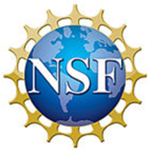NSF
| Founded: | 10 May, 1950 |
| Headquarters: | Arlington, VA |
| Country: | USA |
| Revenue: | $6.9 billion (2010) |
| Website: | nsf.gov |
| Twitter: | |
| Key People | |
| Subra Suresh, Director | |
NSF stands for National Science Foundation. It is a non-profit organization in the United States that supports and funds education and research for all non-medical fields of science and engineering. It is a federal organization which supports research conducted by different United States colleges and universities in various fields of Mathematics, Computer Science, Economics and Social Sciences. NSF funds approximately 20% of all federally-supported research conducted in fields of science and engineering.[1][2]
History
At the end of World War II, an era that saw the invention of Penicillin and the atomic bomb, post-war researchers and scientists found it necessary to have a regulating, organizational body that would assist future scientists and researchers in continuing to expand the frontiers of science and technology. So in 1950, the National Science Foundation was established, with the main objective being to maintain the nation’s dominance in the fields of science and technology. NSF is still the only federal agency dedicated to playing a supportive role in such fundamental research and education. It has provided all the necessary support to thousands scientists and engineers to make some remarkable research; NSF-supported researches have been honored with 170 Nobel Prizes.[3]
Operations
The National Science Foundation provides competitive grants for a pre-determined period to certain proposals from various research centers. On an average, NSF receives 40,000 proposals annually, from which NSF funds about 10,000. These proposals come from all levels of the scientific community, from individuals or group of investigators, to mid-scale research centers, to large research facilities, to national-level research endeavors like Antarctic research sites. It also provides educational scholarships to both graduate and undergraduate students through various programs.
The proposals that are funded are amongst the highest rankers in the merit review process. The merit review is based on standard criteria, which each proposal is compared to by a panel of independent scientists, engineers, and educators who are highly knowledgeable in a field relevant to the proposal. These panel members are not the employees of NSF but are randomly selected by NSF according to their expertise in the field; this member selection process ensures that there is an unbiased evaluation process. All the evaluations are confidential; proposing researchers may see the evaluation, but they cannot see the names of the reviewers.[4][5]
Criteria for the Review process
Criterion 1: Defining the intellectual merit of the proposed activity.
What is the importance of the proposed activity in its field or different fields to advancing knowledge? What is the qualification of the proposer to perform the proposed activity? Is the concept creative and original and to what extent it is so? How well conceived and organized is the proposed activity?
Criterion 2: Defining the broader impacts of the proposed activity.
What are the future prospects of the activity in discovering and understanding, while promoting teaching, training and learning? Can the proposal improve upon such? How well does the proposed activity broaden the participation of groups (e.g., gender, ethnic, disability, geographic, etc.)? How will it improve the education and research in its field? How will the proposed activity benefit society?[6]
ICANN and NSF
In 1991, the U.S. government shifted all responsibility for the non-military portion of ARPANET to the NSF. The National Science Foundation later lifted the restriction on commercial use of the network. NSF and Secretary of Commerce, with a view of increasing competition and create an international participation, founded a nonprofit organization for the administration of Internet, known as ICANN.[7]
References
